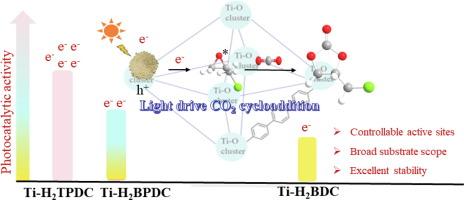Ligand-regulated oxygen vacancies in Ti-MOFs for visible-light-driven CO2 cycloaddition to cyclic carbonates
IF 9
1区 工程技术
Q1 ENGINEERING, CHEMICAL
引用次数: 0
Abstract
Developing sustainable strategies to capture and convert CO2 into value-added chemicals is identified as one of the most promising routes to alleviate the escalating atmospheric CO2 concentration. To make use of solar energy for efficient CO2 utilization, we developed here an organic ligands-regulated strategy for engineering oxygen vacancy density on Ti-based metal-organic frameworks (MOFs). Based on XPS and EPR characterization, the synthesized Ti-based MOF (Ti-H2TPDC) linked with bigger conjugated ligand ([p-terphenyl]-4,4″-dicarboxylic acid) with abundant oxygen vacancies exhibits excellent photocatalytic activity and stability for the cycloaddition reaction of CO2 and epoxides, affording various cyclic carbonates with up to 94 % yield under visible-light irradiation/ambient/solvent-free conditions. Plentiful experimental results demonstrated that both the photogenerated electrons and holes on Ti-H2TPDC can promote the ring-opening step of the cycloaddition reaction. Moreover, the photoelectronic tests indicated that a high concentration of oxygen vacancies with a high atomic ratio of Ti3+/Ti4+ can increase carrier separation, thus enhancing the photocatalytic efficiency for the CO2 cycloaddition reaction.


Ti-MOFs 中配体调控的氧空位,用于可见光驱动的二氧化碳与环碳酸盐的环加成反应
制定可持续战略以捕获二氧化碳并将其转化为增值化学品被认为是缓解大气中不断上升的二氧化碳浓度的最有希望的途径之一。为了利用太阳能高效地利用二氧化碳,我们开发了一种有机配体调控的策略来控制钛基金属有机框架(mof)上的氧空位密度。基于XPS和EPR表征,合成的钛基MOF (Ti-H2TPDC)与更大的共轭配体([对terphenyl]-4,4″-二羧酸)连接,具有丰富的氧空位,在CO2和环氧化物的环加成反应中表现出优异的光催化活性和稳定性,在可见光照射/环境/无溶剂条件下,生成收率高达94% %的各种环状碳酸盐。大量实验结果表明,Ti-H2TPDC上的光生电子和空穴都能促进环加成反应的开环步骤。此外,光电子测试表明,高浓度的氧空位和高Ti3+/Ti4+原子比可以增加载流子的分离,从而提高CO2环加成反应的光催化效率。
本文章由计算机程序翻译,如有差异,请以英文原文为准。
求助全文
约1分钟内获得全文
求助全文
来源期刊

Separation and Purification Technology
工程技术-工程:化工
CiteScore
14.00
自引率
12.80%
发文量
2347
审稿时长
43 days
期刊介绍:
Separation and Purification Technology is a premier journal committed to sharing innovative methods for separation and purification in chemical and environmental engineering, encompassing both homogeneous solutions and heterogeneous mixtures. Our scope includes the separation and/or purification of liquids, vapors, and gases, as well as carbon capture and separation techniques. However, it's important to note that methods solely intended for analytical purposes are not within the scope of the journal. Additionally, disciplines such as soil science, polymer science, and metallurgy fall outside the purview of Separation and Purification Technology. Join us in advancing the field of separation and purification methods for sustainable solutions in chemical and environmental engineering.
 求助内容:
求助内容: 应助结果提醒方式:
应助结果提醒方式:


